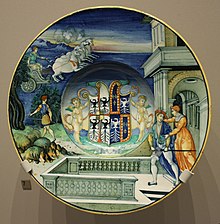Nicola da Urbino


Nicola da Urbino (ca. 1480 – 1540/1547) formerly confused with Nicola Pellipario[1] has traditionally been designated as the Italian ceramicist from Castel Durante in Marche who introduced into painted maiolica the new istoriato style,[2] in which the whole surface of a plate or charger is devoted to a single representational scene. Nicola's scenes were often derived by freely adapting woodcuts from Romances or the Latin classics, such as the illustrated Ovid's Metamorphoses printed at Venice, 1497, to which he returned so often that it appears that a copy of it must have lain in his shop; however, he did not merely copy: "the often crude outlines of the black-and-white figures are converted by him into embodiments of supple vitality," Bernard Rackham observed.[3] Later he gave up book illustrations in favour of compositions of Raphael, mediated through the engravings of Marcantonio Raimondi, and, in at least one case, by direct access to a drawing by Raphael of Michelangelo's David, seen from the rear.[4] Nicola often introduced prominently pieces of schematic and severely frontal architecture in the Renaissance manner. His plate of Solomon Adoring an Idol in the Museo Correr adapts an illustration from Hypnerotomachia Poliphilii.
See also
- Francesco Xanto Avelli, another istoriato maiolica painter.
Notes
- ^ Nicola da Umbria appears in documents; in 1985 Franco Negroni set out to demonstrate that "Nicola Pellipario" was a phantom of art-historical imagination and that the Urbino master with his own shop by 1520 was Nicola da Urbino.
- ^ "The Raphael of maiolica... [who] created the classic style of High Renaissance maiolica" (T. Wilson, Ceramic Art of the Iralian Renaissance [1987] p 44.)
- ^ Rackham, Italian Maiolica (Faber Monographs), p 23.
- ^ Francis Ames-Lewis, "Nicola da Urbino and Raphael" The Burlington Magazine 130 No. 1026 (September 1988), pp. 690-692.
Further reading
- Negroni, Franco, "Nicolò Pellipario, ceramista fantasma" Notizie da Palazzo Albani 14 1985 pp 13–20.
External links
